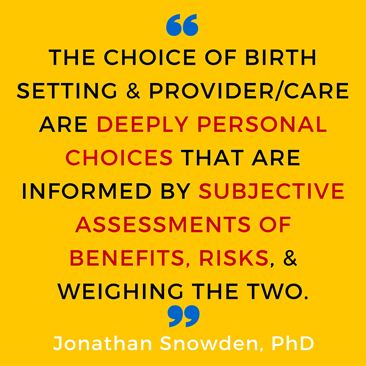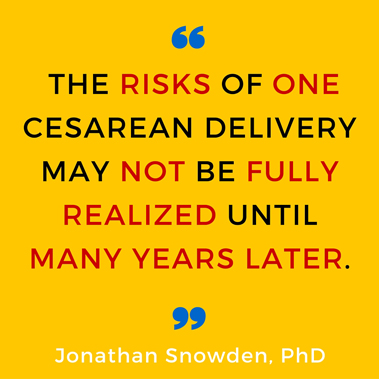January 18, 2016
Understanding Recent Home Birth Research: An Interview with Lead Author Dr. Jonathan Snowden
By: Sharon Muza, BS, LCCE, FACCE, CD/BDT(DONA), CLE | 0 Comments
By Jeanette McCulloch
In th e past month, two new studies have been released - one in the New England Journal of Medicine (NEJM), the other in the Canadian Medical Association Journal (CMAJ) - comparing out-of-hospital birth outcomes to hospital birth outcomes. These studies join a growing body of literature that consistently shows high rates of obstetric intervention in hospitals and also show low risk to neonates regardless of setting. However, the recent NEJM study found a small, but statistically significant increase in risk for perinatal mortality for babies born out-of-hospital. Science & Sensibility shared Henci Goer's thoughts in Dueling Statistics: Is Out-of-Hospital Birth Safe? earlier this month. As a follow up to Henci's post, Jeanette McCulloch of BirthSwell interviewed Melissa Cheyney, PhD, CPM, LDM, Medical Anthropologist, Chair of the Midwives Alliance Division of Research and lead author on the largest study of outcomes for planned home births in the U.S. to date (Cheyney et al. 2014a). You can find that interview here: Understanding Recent Home Birth Research: Guidance for Birth Professionals and Consumers. Today Jeanette speaks with Lead Author Jonathan Snowden, PhD, Epidemiologist and Assistant Professor in the Department of Obstetrics & Gynecology and School of Public Health at Oregon Health & Science University about his thoughts on his NEJM research article. I encourage you to read all three posts, Goer's, Cheyney's and today's with Dr. Snowden to get a full picture of the perspectives on this new research. - Sharon Muza, Science & Sensibility Community Manager.
e past month, two new studies have been released - one in the New England Journal of Medicine (NEJM), the other in the Canadian Medical Association Journal (CMAJ) - comparing out-of-hospital birth outcomes to hospital birth outcomes. These studies join a growing body of literature that consistently shows high rates of obstetric intervention in hospitals and also show low risk to neonates regardless of setting. However, the recent NEJM study found a small, but statistically significant increase in risk for perinatal mortality for babies born out-of-hospital. Science & Sensibility shared Henci Goer's thoughts in Dueling Statistics: Is Out-of-Hospital Birth Safe? earlier this month. As a follow up to Henci's post, Jeanette McCulloch of BirthSwell interviewed Melissa Cheyney, PhD, CPM, LDM, Medical Anthropologist, Chair of the Midwives Alliance Division of Research and lead author on the largest study of outcomes for planned home births in the U.S. to date (Cheyney et al. 2014a). You can find that interview here: Understanding Recent Home Birth Research: Guidance for Birth Professionals and Consumers. Today Jeanette speaks with Lead Author Jonathan Snowden, PhD, Epidemiologist and Assistant Professor in the Department of Obstetrics & Gynecology and School of Public Health at Oregon Health & Science University about his thoughts on his NEJM research article. I encourage you to read all three posts, Goer's, Cheyney's and today's with Dr. Snowden to get a full picture of the perspectives on this new research. - Sharon Muza, Science & Sensibility Community Manager.
Jeanette McCulloch: Dr. Snowden, your research suggests a significantly lower risk of interventions for mothers who plan home and birth center births. What might hospital providers take away from this study that could help improve maternal outcomes?
Jonathan Snowden: I agree, the finding of lower obstetric interventions in the out of hospital setting is an important one, and highlights the need for reform in the U.S. maternity care system. While Oregon's planned in-hospital cesarean rate of 15% is lower than the national average, it is still higher than the recommended levels (10-15% based on the WHO recommendations from decades ago, and 19%, according to a recent study in JAMA (Molina et al. 2015). Although C-sections can be a life-saving procedure, they are currently over-used, and they carry both short-term and long-term risks for mothers and babies. In particular, the health of a woman and her babies during her future pregnancies can be adversely affected by the first cesarean, so the risks of one cesarean delivery may not be fully realized until many years later.
We believe that a key message for in-hospital providers from our study is the importance of recognizing healthy low-risk pregnancy and labor as physiologic processes that will proceed to a healthy outcome in a majority of cases. Recognizing this, obstetric interventions can be reserved for when complications arise and they become necessary, or when they become judicious, from the perspective of the woman and her provider. Hospital providers may use this information as rationale to more deeply explore how to better support physiologic labor processes, and also to better support clinician decision making, for example factors that encourage adoption of more contemporary definitions of normal labor progress. We also believe that structural factors in the U.S. maternity care system, separate from the individual choices of mothers and providers, contribute to procedure overuse in U.S. hospitals. Further, given such a large difference in cesarean delivery in the two groups we studied, it suggests that there are opportunities to better study why such differences exist. If practices can be imported from the out-of-hospital setting to the in-hospital setting that will safely reduce cesarean births, that would be an impactful benefit of such research.
Because our findings identify different risks in both in and out of hospital settings, we feel this is an opportunity for all maternity care providers to seek to learn from each other. As Dr. Cheyney mentioned in her interview with you earlier this month, while the higher risk for perinatal death identified by our research tends to garner more media attention, our findings regarding differences in cesarean delivery propose that in hospital providers and systems may benefit from emulating home and birth center approaches to care as we seek to meet the national goal of safe cesarean section reduction.
JMc: The degree to which out-of-hospital providers are integrated into the larger maternal health care system varies from community to community. Dr. Snowden, you and your colleagues cited the lack of integration as potentially impacting outcomes in the U.S. What are some signs of safe coordination that families can look for - and policy makers can advocate for - in their own communities?
JS: I echo Dr. Cheyney's points that she mentioned in her interview with you about the importance of open, mutually-respectful communication between out-of-hospital and in-hospital obstetric providers to more fully integrate the U.S. maternity care system across birth settings, and to improve birth outcomes for women and babies in all settings. Defining specifically what a more integrated maternity care system will look like is more challenging. The fragmentation in our healthcare system is a more general issue in U.S. healthcare, not just in maternity care.
I recently participated in an online forum sponsored by NEJM with other maternity care experts in the U.S., Canada, the U.K., and the Netherlands, and researchers and policymakers shared approaches to integration of maternity care that have worked in those countries. Themes that emerged included: open and respectful communication between out-of-hospital and in-hospital providers, collaborative and mutually agreed-upon protocols for seamless transfer of care when complications arise, and risk-based guidelines for who is an optimal candidate for out-of-hospital birth (with the recognition that ultimately, a woman makes this choice). The formal guidelines put forth in the U.K. provide an excellent example of out-of-hospital birth being integrated into the broader maternity care system there. Equally important as broad formal guidelines is the communication of options, benefits, and risks to women in clear and nonjudgmental language. For example, individual maternity care services and universities in the U.K. have created user-friendly leaflets and infographics to clearly explain birthplace options to women. We could better integrate U.S. maternity care across birth settings, and help women understand their options, by emulating these approaches in the U.S.
 JMc: Dr. Snowden, in your piece, you and your coauthors suggest that people who select out-of-hospital birth may have different values and goals for birth. Opponents sometimes suggest that home and birth center families are choosing an experience over the well being of their baby. In your experiences, what values do you think are influencing place of birth decision making?
JMc: Dr. Snowden, in your piece, you and your coauthors suggest that people who select out-of-hospital birth may have different values and goals for birth. Opponents sometimes suggest that home and birth center families are choosing an experience over the well being of their baby. In your experiences, what values do you think are influencing place of birth decision making?
JS: That women who choose out-of-hospital birth have a different decision-making process on birth setting than women who choose hospital birth seems evident, and research has begun to explore exactly what these differences are. Some of the factors that have been documented which we discussed in our paper include a woman's control over her surroundings and preferences for a physiologic birth and avoidance of unnecessary interventions (in the case of out-of-hospital birth), and access to pain relief and emergency medical services, in the case of hospital birth. That said, these average differences should not detract from the fact that there is great diversity in values, preferences, and decision-making within women who choose any single birth setting. This is at the heart of our research on this topic, and discussion of this topic: the choice of birth setting and provider/care are deeply personal choices that are informed by subjective assessments of benefits, risks, and weighing the two. In my research on birth setting, I strive to provide valid estimates of specific, measurable outcomes (risks as well as healthy outcomes), to equip providers, policymakers, and most importantly women with the best available information to inform their choice.
I disagree with the notion that women and families who choose out-of-hospital birth settings are privileging an experience over the health of their baby. It's important to refrain from judging others' motivations in this very personal decision. We all share the goal of a healthy outcome for moms and babies, even when we weigh various factors differently in our individual definition of that outcome. And it's worth noting that U.S. healthcare is moving toward the principle of patient-centeredness more broadly, incorporating individual patients' perspectives about what matters to them into designing healthcare systems, evaluating treatment/care options, and research on outcomes. Maternity care must follow this broad trend as well - in fact, I believe that we are in a great position to lead the way. For this reason, we advocate for more fine-grained research on women's birthing experiences and preferences (including qualitative and social science research). My colleague Ellen Tilden and I are currently pursuing further research in this vein.
JMc: As a researcher, you advocate for comprehensive data collection with a goal of shining a light on best practices for improving infant and maternal well-being. Oregon has made specific changes with the goal of improving data collection. Would you advocate for similar changes in every state? What are best practices for birth certificates?
JS: My co-authors and I would advocate for such changes in birth certificate data collection in every state. We appreciate the leadership shown by the Oregon Center for Health Statistics, researchers, advocates, and policymakers in our state, which made this change possible. First and foremost, we believe it is essential to understand the intended place of birth, and the credential of the intended birth attendant (e.g., obstetrician, certified nurse-midwife, certified professional midwife, etc.) for women when they entered labor, not just in the setting where they eventually delivered. This matters because of the 'intention-to-treat' principle in epidemiology, whereby we care about the planned exposure (e.g., treatment, birth setting, healthcare decision), and not just what ended up occurring after the fact.
Furthermore, we recommend collecting data on birth setting in a fine-grained way that distinguishes between the hospital setting, the home setting, and freestanding birth centers. Although we collapsed birth centers and the home setting into one 'out-of-hospital' category in some analyses in our study, we recognize that there are important differences between the two, so it's important to collect data on these settings separately. Although changing vital statistics collection protocols can add to regulatory burden, we believe that having the most detailed and accurate data possible empowers women and their providers to better understand their options in each birth setting and make informed choices about their birthing preferences. Finally, it must be noted again that while birth certificate data boast many strengths, the birth certificate is not designed for research. Other more fine-grained research data must be collected and analyzed to provide a more complete picture of the benefits and risks of birth in different settings.
In addition to the issues above, it would be wonderful if we invested broadly in a public health data system and analytic enterprise that would capture much greater detail on a wide range of health conditions - both pathological processes of disease and healthy, normal physiologic processes. In the setting of childbirth, this includes: greater detail on labor processes, labor management, length of labor, and greater specificity in the complications experienced by mothers and babies, as well as healthy outcomes free from complications. Finally, efforts towards greater verification of data accuracy would greatly enhance our ability to answer clinical and population-level questions in order to improve health care, health outcomes, and population health.
JMc: Once states have this sort of data collection in place, how can individual states use the data to ensure improvement across all settings?
JS: Accurate data collection, data monitoring, research, and collaborative quality improvement will be essential to improve maternal and infant outcomes across all U.S. birth settings. While honing data collection practices and research (as we have done in Oregon) are an important first step, it will be equally important for all of us - researchers, policymakers, in- and out-of-hospital obstetric providers, and the women we care for - to join in an open, constructive, and mutually respectful discussion about improving the care and outcomes for women and babies. A key implication of our study is that in the U.S., there's room to improve obstetric care in all birth settings and to improve the healthcare system in which we provide that care. We recommend looking to Canada, the Netherlands, and the U.K. for examples of healthcare systems that offer women care in multiple birth settings (including the home and hospital), and which have systems in place to offer seamless transfer of care between those settings. In particular, we advocate for adoption of risk-based protocols for which women are optimal candidates for out-of-hospital birth, collaborative agreements between in- and out-of-hospital providers for the transfer of care, and a greater role for midwives meeting ICM standards in caring for healthy childbearing women in the U.S. This collaborative, woman-centered system of obstetric care would help us all make progress toward our common goal of a safe birth for every woman and baby and a positive, respectful birthing experience.
JMc: This study has received significant attention in the media and in policy discussions. Are you surprised at the attention this study has received? Are you satisfied with the messages that people are taking away from it?
JS: I have been doing research on birth setting, models of obstetric care, and systems factors in obstetric care for many years now - comparing birth outcomes across different types of hospitals, analyzing provider-level characteristics, determining if outcomes differ by types of days in a hospital's labor & delivery unit, and comparing out-of-hospital birth settings and care to the hospital setting and hospital-based care. My research goal is broadly the same in these studies: to determine which maternal and infant outcomes differ by these factors, and where possible, to determine why. Although I don't see research comparing the out-of-hospital setting to the hospital setting as being so different from my studies that compare outcomes across hospitals, I've learned that for many people and in particular for the popular media, out-of-hospital birth can be an emotionally charged topic, and one which draws attention. So, my co-authors and I were not surprised by the attention our study has attracted.
That said, I have been encouraged by some of the messages that people seem to be taking away from the study, and from the discussion that the study has engendered. More and more, I'm hearing nuanced and cross-disciplinary discussion on the topic of birth setting, and in discussions with providers, fellow researchers, and friends, I've heard some points of mutual agreement emerge. For instance, there seems to be momentum behind the principles of integration of maternity care across settings, and ensuring that women have several options for safe and respectful care during childbirth in various setting in the U.S. The online NEJM forum has also given us a venue to learn valuable information from our Dutch and British colleagues on how to organize such a maternity care system, with home birth as an option within that system. This response has left me and my co-authors hopeful about making progress in the U.S. - hopeful that we can move beyond the polarization and engage in productive dialogue about how best to improve safety in both out-of-hospital birth and hospital birth.
There's a real dearth of research on the topics of childbirth setting and care - a key conclusion of the Institute of Medicine's expert workshop a couple years ago was that more research is needed on these topics. (Institute of Medicine and National Research Council, 2013). I believe that filling these gaps will be essential to improving the U.S.'s rates of death and harm during childbirth, which are unacceptably high compared to the rest of the developed world. The racial disparities in both infant and maternal outcomes are equally unacceptable, and demand our attention. I believe that scientifically valid and nonjudgmental research on obstetric care and birth setting - along with interdisciplinary collaboration, open and respectful communication, and systems-level changes - will be essential to improving these outcomes.
References
Boucher D, Bennett C, McFarlin B, Freeze R. Staying home to give birth: why women in the United States choose home birth. J Midwifery Womens Health. Mar-Apr 2009;54(2):119-126.
Cheyney, M. et al. (2014a) Outcomes of Care for 16,924 Panned Home Births in the United States: The Midwives Alliance of North America Statistics Project, 2004 to 2009. J Midwifery Womens Health, 59(1); 17-27. DOI: 10.1111/jmwh.12172
Cheyney, M. et al. (2014b) Development and Validation of a National Data Registry for Midwife-Led Births: The Midwives Alliance of North America Statistics Project 2.0 Dataset. J Midwifery Womens Health, 59(1): 8-16. DOI: 10.1111/jmwh.12165.
Cheyney, M., Bovbjerg, M. L., & Burcher, P. (2015). Home birth is unsafe: AGAINST: Safe for whom?. BJOG: An International Journal of Obstetrics & Gynaecology, 122(9), 1235-1235.
Cheyney, M., Everson, C., & Burcher, P. (2014). Homebirth Transfers in the United States Narratives of Risk, Fear, and Mutual Accommodation.Qualitative health research, 24(4), 443-456.
Declercq E, Sakala C, Corry M, Applebaum S, Herrlich A. Listening to Mothers III: Pregnancy and Birth. New York: Childbirth Connection;2013.
Goer, H. (2015, January 5). Dueling statistics: is out-of-hospital birth safe? [Web log post]. Retrieved from http://www.scienceandsensibility.org/blog/dueling-statistics-is-out-of-hospital-birth-safe
Hutton, E. K., Cappelletti, A., Reitsma, A. H., Simioni, J., Horne, J., McGregor, C., & Ahmed, R. J. (2015). Outcomes associated with planned place of birth among women with low-risk pregnancies.CMAJ.
IOM (Institute of Medicine) and NRC (National Research Council). 2013. An update on research issues in the assessment of birth settings: Workshop Summary. Washington D.C: National Academies Press.
Molina G, Weiser TG, Lipsitz SR, et al. Relationship Between Cesarean Delivery Rate and Maternal and Neonatal Mortality.JAMA. 2015;314(21):2263-2270. doi:10.1001/jama.2015.15553.
Murray-Davis B, McDonald H, Rietsma A, Coubrough M, Hutton E. Deciding on home or hospital birth: results of the Ontario Choice of Birthplace Survey. Midwifery. Jul 2014;30(7):869-876.
Murray-Davis B, McNiven P, McDonald H, Malott A, Elarar L, Hutton E. Why home birth? A qualitative study exploring women's decision making about place of birth in two Canadian provinces.Midwifery. Oct 2012;28(5):576-581.
Piper JM, Mitchel EF Jr, Snowden M, et al. Validation of 1989 Tennessee birth certificates using maternal and newborn hospital records. Am J Epidemiol 1993:137(7);758-768.
Reichman NE, Schwartz-Soicher O. Accuracy of birth certificate data by risk factors and outcomes: Analysis data from New Jersey. Am J Obstet Gynecol. 2007;197(1):32.e1-e8.
Roome, S., Hartz, D., Tracy, S., & Welsh, A. W. (2015). Why such differing stances? A review of position statements on home birth from professional colleges. BJOG: An International Journal of Obstetrics & Gynaecology.
Snowden, J. M., Tilden, E. L., Snyder, J., Quigley, B., Caughey, A. B., & Cheng, Y. W. (2015). Planned out-of-hospital birth and birth outcomes. New England Journal of Medicine, 373(27), 2642-2653.
About Jeanette McCulloch and Jonathan Snowden
 Jeanette McCulloch, BA, IBCLC has been combining strategic communications and women's health advocacy for more than 20 years. Jeanette is a co-founder of BirthSwell, helping birth and breastfeeding organizations, professionals, and advocates use digital tools and social media strategy to improve infant and maternal health. She provides strategic communications consulting for state, national, and international birth and breastfeeding organizations. A board member of Citizens for Midwifery, she is passionate about consumers being actively involved in health care policy.
Jeanette McCulloch, BA, IBCLC has been combining strategic communications and women's health advocacy for more than 20 years. Jeanette is a co-founder of BirthSwell, helping birth and breastfeeding organizations, professionals, and advocates use digital tools and social media strategy to improve infant and maternal health. She provides strategic communications consulting for state, national, and international birth and breastfeeding organizations. A board member of Citizens for Midwifery, she is passionate about consumers being actively involved in health care policy.

Jonathan Snowden, PhD, is an epidemiologist and an Assistant Professor in the Department of Obstetrics & Gynecology at Oregon Health & Science University (OHSU) and in the new OHSU/Portland State University School of Public Health. Dr. Snowden is a leading expert in statistical methodology for analyzing large databases for clinically- and policy-actionable results, and his content focus is reproductive health. His policy experience includes service in the California State Legislature as a Senate Fellow, and his postdoctoral training at OHSU was supported by a career development award from the Eunice Kennedy ShriverNational Center of Child Health and Human Development (NICHD).
Dr. Snowden's work has been published widely in leading medical and methodological journals, including BMJ, Epidemiology, and Obstetrics & Gynecology. He works at the interface of medicine, public health, and healthcare policy, analyzing healthcare systems factors to strengthen the evidence base for high-quality obstetric care. The broad goals of his research are: (1) to enable a safe delivery for every mother and baby (2) to close disparities and improve the health of racial minorities and sexual minorities.
Tags
Breastfeeding Childbirth education Research Home Birth Midwives Out of hospital birth Professional Resources Labor/Birth Midwifery Jeanette McCulloch Mother-baby bonding improvement Jonathan Snowden